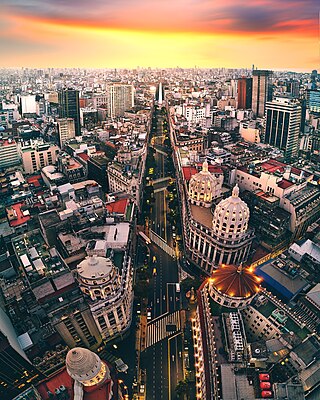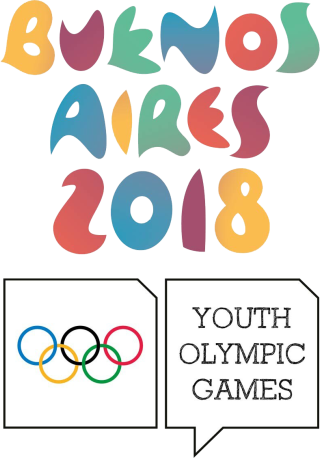
The Buenos Aires Underground, locally known as Subte, is a rapid transit system that serves the area of the city of Buenos Aires, Argentina. The first section of this network opened in 1913, making it the 13th earliest subway network in the world and the first underground railway in Latin America, the Southern Hemisphere, and the Spanish-speaking world, with the Madrid Metro opening nearly six years later, in 1919. As of 2023, Buenos Aires is the only Argentine city with a metro system.

Line A is the oldest line of the Buenos Aires Underground. Opened to the public on 1 December 1913, it was the first underground line in South America, the Southern Hemisphere and the Spanish-speaking world. It made Buenos Aires the 13th city in the world to have an underground transport service. The line stretches 9.8 km (6.1 mi) from Plaza de Mayo and San Pedrito and runs under the full length of the Avenida de Mayo and part of the Avenida Rivadavia, and is used by 258,000 people per day.

Line B of the Buenos Aires Underground runs 11.75 kilometres (7.30 mi) from Leandro N. Alem to Juan Manuel de Rosas in Villa Urquiza. Line B opened to the public on 17 October 1930.

Caballito is a barrio (neighborhood) of the Argentine capital, Buenos Aires. It is the only barrio in the administrative division Comuna 6.

Federico Lacroze railway station is a passenger railway station in Buenos Aires, Argentina. The station is located in the city's outlying barrio (neighbourhood) of Chacarita in a predominantly residential area. It is just a short distance north of the Cementerio de la Chacarita, the city's largest cemetery. The station is named after Federico Lacroze, a prominent 19th century Argentine railway and transport pioneer who obtained the concession for building the Buenos Aires Central Railway in 1884. When the Argentine railway network was nationalised in 1948 the station became the Buenos Aires terminus for the lines that became part of the General Urquiza Railway (FCGU).

The General Urquiza Railway (FCGU), named after the Argentine general and politician Justo José de Urquiza, is a standard gauge railway of Argentina which runs approximately northwards from Buenos Aires to Posadas, with several branches in between. It was also one of the six state-owned Argentine railway companies formed after President Juan Perón's nationalisation of the railway network in 1948. The six companies were managed by Ferrocarriles Argentinos which was later broken up during the process of railway privatisation beginning in 1991 during Carlos Menem's presidency.

Avenida Roque Sáenz Peña, better known as Diagonal Norte, is an important avenue in the San Nicolás neighborhood of Buenos Aires, Argentina. It is oriented south-east/north-west, diagonally bisecting the city blocks (manzanas) which give the city centre a checkerboard plan. It is named after President Roque Sáenz Peña, who held power from 1910 to 1914 and passed the law which established universal suffrage, secret ballot and an electoral register.

The 2018 Summer Youth Olympics, officially known as the III Summer Youth Olympic Games, and commonly known as Buenos Aires 2018, were an international sports, cultural, and educational event held from 6 to 18 October 2018 in Buenos Aires, Argentina. They were the first Youth Olympic Games held outside of Eurasia, and the first Summer Games held outside of Asia and the first to be held in the Western and Southern hemispheres. It was the second Olympic Games held in South America after the 2016 Summer Olympics in Rio de Janeiro, Brazil.

Federico Lacroze is an underground station on Line B of the Buenos Aires Underground named after the Argentine railway entrepreneur, located at the intersection of Corrientes and Federico Lacroze avenues in the Chacarita neighbourhood and near the La Chacarita Cemetery. The station was opened on 17 October 1930 as the western terminus of the extension of the line from Federico Lacroze to Callao.

Plaza Miserere is a station on Line A of the Buenos Aires Underground. The station is located between Alberti and Loria / Pasco stations on the A line underground. Plaza Miserere has interchange with Once underground station of the H line and connection to the Sarmiento line commuter rail service within Once railway station, the central station of the Domingo Faustino Sarmiento Railway.

Primera Junta is a station on Line A of the Buenos Aires Underground. It lies at the intersection of Rivadavia Avenue and Del Barco Centenera street, in the neighborhood of Caballito and connects with Caballito station on the Sarmiento Line commuter rail service. The Buenos Aires Historic Tramway operates tram cars on a 12-block loop of street tracks used by rapid transit trains en route to the Polvorín Workshop. The station was opened on 1 July 1914 as the western terminus of the extension of the line from Río de Janeiro. It served as the line's terminus until 23 December 2008, when the line was extended to Carabobo.

Acoyte is a station on Line A of the Buenos Aires Metro. The station was opened on 1 July 1914 as part of the extension of the line from Río de Janeiro to Primera Junta.

Castro Barros is a station on Line A of the Buenos Aires Metro. The station was opened on 1 April 1914 as part of the extension of the line from Plaza Miserere to Río de Janeiro.

Loria is a station on Line A of the Buenos Aires Underground. The station was opened on 1 April 1914 as part of the extension of the line from Plaza Miserere to Río de Janeiro.

Sáenz Peña is a station on Line A of the Buenos Aires Underground. It is the last station of the line located under the Avenida de Mayo in the neighbourhood of Monserrat. The station belonged to the inaugural section of the Buenos Aires Underground opened on 1 December 1913, which linked the stations Plaza Miserere and Plaza de Mayo.

Ángel Gallardo is a station on Line B of the Buenos Aires Underground. This is the station for Parque Centenario and the Natural History Museum.

Entre Ríos - Rodolfo Walsh is a station on Line E of the Buenos Aires Underground. The station was opened on 20 June 1944 as part of the inaugural section of the line from San José to General Urquiza.

Federico Lacroze was an Argentine businessman and railway entrepreneur. He created the first tram line in Buenos Aires and his Buenos Aires Central Railway helped link the provinces of Entre Ríos, Corrientes and Misiones by rail to Argentina's capital. Lacroze is buried in La Recoleta Cemetery, Buenos Aires.
Uruguay Station or Uruguai Station may refer to:


















